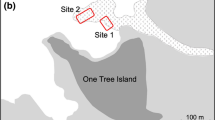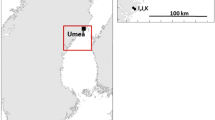Summary
The biological and physical factors that affect the distribution of the subtidal, epibenthic, sand-dwelling cnidarian Renilla kollikeri along a depth gradient from 2 to 13 m were determined by manipulative field and laboratory experiments. The sea pansy's nearshore distributional limit (2.5 m in depth) was set by the animal's inability to remain anchored on the bottom in the face of increasing wave surge associated with shallow water. Renilla was outcompeted for space by the sand dollar Dendraster excentricus in an area between 6 and 9 m in depth and was largely excluded from the substrate when sand dollar densities exceeded 350/m2. Predator-prey interactions also influence the Renilla distribution. The asteroid Astropecten brasiliensis feeds on and removes Renilla 40 mm and less in diameter from areas seaward of the sand dollar bed (9 m in depth). Astropecten did not forage in the shallow area where Renilla was most abundant because of its intolerance to wave surge and because of its difficulty in crossing the sand dollar bed. The nudibranch Armina californica fed on Renilla throughout the depth gradient but did not remove colonies greater than 20 mm in diameter because of the Armina- specific escape behavior of Renilla. The foraging behavior of Armina was also curtailed by strong surge conditions. The nearshore area (3–6 m in depth) of high Renilla density was a refuge in which animals that had settled from the plankton could escape predation. As the animals grow they lose their ability to anchor in the substrate in shallow water and thus move into deeper water. The results of multiway interactions among sets of three species, particularly the beneficial results of the competitive interaction with Dendraster in light of the activities of the predators are discussed with reference to the abundance and distribution of Renilla.
Similar content being viewed by others
References
Birkeland C (1974) Interaction between a sea pen and seven of its predators. Ecol Monogr 54:211–232
Charnov EL, Orians GH, Hyatt K (1976) Ecological implications of resource depression. Am Nat 110:247–259
Connell JH (1961) Effects of competition, predation by Thais, and other factors of natural populations of the barnacle Balanus balanoides. Ecol Monogr 31:162–170
Connell, JH (1961a) The influence of interspecific competition and other factors on the distribution of the barnacle Chthmalus stellatus. Ecology 42:710–723
Connell JH (1970) A predator-prey system in the marine intertidal region. I. Balanus glandula and several predatory species of Thais. Ecol Monogr 40:49–78
Cubit JD (1975) Interactions of seasonally changing physical factors and grazing affecting high intertidal communities on a rocky shore. Ph D Thesis Univ Oregon, Eugene
Davis N (1978) Studies of the southern California nearshore and bottom community. Ph D Thesis Univ California, San Diego
Dayton PK (1971) Competition, disturbance and community organization: The provision and subsequent utilization of space in a rocky intertidal community. Ecol Monogr 41:351–389
Harger JRE (1970) The effect of wave impact on some aspects of the biology of sea mussels. Veliger 12:401–414
Kastendiek J (1975) The role of behavior and interspecific interactions in determining the distribution and abundance of Renilla kollikeri Pfeffer, a member of a subtidal sand bottom community. Ph D Thesis Univ California, Los Angles
Kastendiek J (1976) Behavior of the sea pansy Renilla kollikeri Pfeffer (Coelenterata: Pennatulacea) and its influence on the distribution and biological interactions of the species. Biol Bull 151:518–537
Landenberger DE (1967) A study of predation and predatory behavior in the Pacific starfish Pisaster. Ph D Thesis Univ California, Santa Barbara
Lewis JR (1968) Water movements and their role in rocky shore ecology. Sarsia 34:13–36
Lilly SJ, Sloane JF, Bassingdale R, Ebling FJ, Kitching JA (1953) The ecology of Lough Ine with special reference to water currents. IV. The sedentary fauna of sublittoral boulders. J Anim Ecol 22:87–122
Lissner AL (1980) Some effects of turbulence on the activity of the sea urchin Centrostephanus coronatus Verrill. J exp mar Biol Ecol 48:185–193
Lubchenco J, Menge BA (1978) Community development and persistence in a rocky intertidal zone. Ecol Monogr 48:67–94
Menge BA (1972) Competition for food between two intertidal starfish species and its effect on body size and feeding. Ecology 53:635–644
Menge BA (1976) Organization of the New England rocky intertidal community: role of predation, competition and environmental heterogeneity. Ecol Monogr 46:355–393
Morin JG, Kastendiek J, Harrington A, Davis N (in prep) The structure of a shallow subtidal sand community in space and time.
Paine RT (1969) Natural history, limiting factors and energetics of the opisthobranch Navanax inermis. Ecology 46:603–619
Paine RT (1974) Intertidal community structure. Experimental studies on the relationship between a dominant competitor and its principal predator. Oecologia (Berl) 15:93–120
Peterson CH (1977) competitive organization of the soft-bottom macrobenthic communities of southern California lagoons. Mar Biol 43:343–359
Peterson CH (1979) Predation, competitive exclusion, and diversity in the soft-sediment benthic communities of estuaries and lagoons. In: RJ Livingston (ed), Ecological processes in coastal and marine systems. Plenum, Oxford-New York p 233–264
Peterson CH, Andre SV (1980) An experimental analysis of interspecific competition among marine filter-feeders in a soft-sediment environment. Ecology 61:129–139
Schroeter SC (1978) Experimental studies of competition as a factor affecting the distribution and abundance of Purple Sea Urchins, Strongylocentrotus purpuratus (Stimpson). Ph D Thesis Univ California, Santa Barbara
Southward AJ, Orton JH (1954) The effects of wave-action on the distribution and numbers of the commoner plants and animals living on the Plymouth breakwater. J Mar Biol Ass U K 33:1–19
Virnstein RW (1977) The importance of predation by crabs and fishes on benthic infauna in Chesapeake Bay. Ecology 58:1199–1217
Wilson EB (1883) Development of Renilla. Roy Soc Lond Philos Trans 174:728–823
Woodin SA (1974) Polychaete abundance patterns in a marine soft-sediment environment: the importance of biological interactions. Ecol Monogr 44:171–187
Author information
Authors and Affiliations
Rights and permissions
About this article
Cite this article
Kastendiek, J. Factors determining the distribution of the sea pansy, Renilla kollikeri, in a subtidal sand-bottom habitat. Oecologia 52, 340–347 (1982). https://doi.org/10.1007/BF00367957
Received:
Issue Date:
DOI: https://doi.org/10.1007/BF00367957




